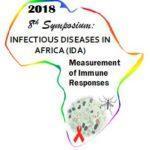The 8th Infectious Diseases in Africa symposium was kicked off by an interesting session on “Immune responses at mucosal sites”. During this session faculty from Malawi, South Africa and the United States of America, highlighted how immunity at the mucosal barriers influences acquisition and control of infection.
The mucosal sites are usually the first entry points of HIV, hence this site is one of the key target areas for anti-HIV immune interventions. To emphasize this point, Thomas J Hope (from Northwestern University, see video) stated that “Studying the immune system in the blood only, is like studying the highway to understand human behavior”. In this vein, researchers in the HIV field are developing various techniques to visualise HIV in mucosal tissue, including the use of fluorescing viruses during in vivo non-human primate challenges. These visualization approaches have shown that HIV susceptibility at mucosal barriers occurs at areas of weak barrier integrity. Where, langerhans and resident T-cell are the first cells to be encountered. In this environment protective (mucosal) antibodies could be important in improving barrier function and preventing dissemination of the virus.
One of the factors affecting mucosal barrier function is the microbiome existing at these sites. In the vaginal mucosal region, bacterial vaginosis has been shown to increase HIV infection risk by inducing local inflammation (Heather Jaspan, University of Cape Town, see video). Heather Jaspan also highlighted that non-exclusive breastfeeding can contribute to dysbiosis of the gut microbiome. This dysbiosis was illustrated by increased microbial diversity is associated with increased inflammation.
In all these studies, perhaps lessons can be learnt from the lung mucosal barrier, which despite having the largest surface area exposed to the exterior environment, it still manages to mount an effective protective barrier. One reason for this observation is the tight balance in the immunological regulatory processes occurring in the lung (Kondwani Jambo, Malawi-Liverpool Welcome Trust, see video). However, upon HIV exposure studies have shown significant differences in immune cell dynamics in the lung. Where, once HIV infection has occurred, control of the infection is difficult even when effective T cell mediated immune responses are detected in the blood.
Once HIV manages to cross the mucosal barrier, HIV gets rapidly transferred to other tissues such as lymphoid tissues where high HIV replication occurs. Some of the reasons suggested to contribute to the apparent lack of HIV replication control, is the inability of T cells that would be effective at controlling viruses are excluded from these organs. Michael Betts (University of Pennsylvannia), highlighted research that supports this, where he demonstrated that not all lymphocyte equivalently recirculate between the blood and tissue. Interestingly, he showed clear difference in the functional capacity between CD8 T cells detected in the blood, and those observed in the lymphatics.
In addition to the interesting findings presented by the faculty, students also had an opportunity to present their findings that covered diverse aspects of HIV research. Poster sessions highlighted HIV infection related impairments that ranged from dissociation of the DARC-null polymorphism to CD8+ T-cells dysfunctions (Zesuliwe Shangase) in HIV+ individuals to perturbation of B-cell function in the bronchoalvealar lavage due to chronic HIV infections (Joseph Phiri). A study in IL-2, Immunoglobulin proteins and select hematology parameters showed significant HIV-related dysregulation of these factors compared to the control (Rita Essien) while another study highlighted the significant numbers of HIV related TB, cryptococcal meningitis, anaemia and malaria as major causes of mortality and morbidity in males (Marcel Turatsinze). A peculiar duplication invent was shown in tracing the evolutionary pathway of an HIV broadly neutralising antibody (BnAb), yet again showing the non-conventional manner bNaBs are generated in HIV (Vincent Hlatshwayo). A prospective study on the dysregulation of Th1/Th2 cytokines in conjoint cases of HIV and pregnancy was also highlighted, showing significantly higher levels of interferon gamma, IL-10 and IL-4 among the HIV infected participants compared to the uninfected in Western Kenya (Stanslaus Musyoki).
Summary by Clive Michelo
